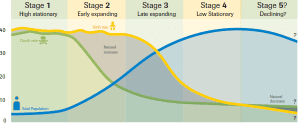Calls came into our office this month from teachers at two DC area high schools asking for guest speakers on population for their AP Human Geography classes. It wasn’t a coincidence. This is October – the month that the teachers get to the “Population and Migration” unit in their syllabus for the AP course.
It’s always a great opportunity to work with local students. Last week, I was a guest in the AP Human Geography classes at McKinley Technical High School here in Washington, where I led the students in our global simulation, Food for Thought. Students are divided into world regions according to relative population size (2/3 wind up in the Asia region, for example) and then we examine statistics that define the demographics and quality of life around the world. This activity is a natural for the AP course because it touches on so many of the concepts that might appear on the final exam – birth, death and fertility rates, literacy, public health, urbanization, energy use and wealth (represented Hershey chocolate kisses – always a favorite!) After looking at the numbers, we discuss correlations and causalities. How does women’s literacy rate affect fertility trends? How does GDP relate to population growth, life expectancy and migration?
When the College Board designed the course outline, they, no doubt, wanted population issues addressed early in the school year, to serve as a foundation for other topics to come – land use and agriculture, industrialization, development and human impacts on the natural environment, gender roles, global economics and more. Since the AP Human Geo course was launched in 2001, it has grown steadily in popularity. Today, nearly 200,000 students take the course each year. The Population unit represents 13-17% of the course (3-4 weeks), giving teachers time to supplement dense textbooks with hands-on activities like Food for Thought, Power of the Pyramids and many others you’ll find on this site.




